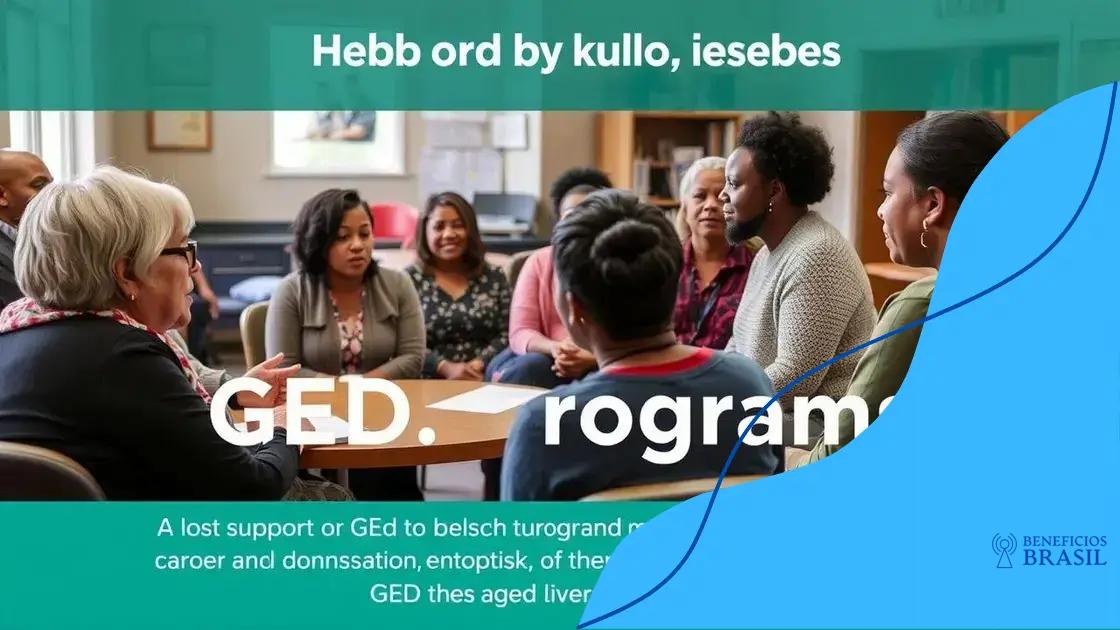Expansion of free GED programs is transforming education

The expansion of free GED programs significantly enhances educational access, improves job prospects, and addresses barriers such as financial constraints, making essential skills more attainable for individuals seeking a better future.
Expansion of free GED programs is reshaping the landscape of adult education, making it accessible to a broader audience. Have you ever wondered how these programs might change lives by offering new opportunities?
Understanding free GED programs
Understanding free GED programs is essential in today’s educational landscape. These programs are designed to help individuals who haven’t completed high school obtain their GED, which is as valuable as a traditional diploma. With the expansion of free GED programs, access to education has become more widespread, providing opportunities for many who wish to improve their educational qualifications.
What are free GED programs?
Free GED programs are educational initiatives that allow students to prepare for the General Educational Development (GED) test without financial constraints. These programs often include classes, study materials, and tutoring, all offered at no charge. By removing the financial barriers, more people can pursue their educational goals.
Benefits of enrolling in free GED programs
Participating in free GED programs provides numerous advantages:
- Cost-effective education: Students can prepare for the GED test without any fees.
- Flexible schedules: Many programs offer evening or weekend classes to accommodate working adults.
- Supportive environment: Learners receive guidance from instructors and peers, fostering a strong support network.
- Improved job prospects: Earning a GED enhances employment opportunities, leading to better jobs and higher salaries.
These benefits illustrate the significance of free GED programs in the lives of countless individuals.
Another aspect to consider is the accessibility of these programs. Many community organizations, non-profits, and educational institutions offer free GED preparation courses. This localized effort makes it easier for individuals in various communities to find programs that suit their needs. The evolution of online and blended learning has also contributed to this accessibility, allowing students to study at their own pace.
In conclusion, understanding free GED programs highlights their importance in promoting education and providing essential opportunities for those seeking to improve their qualifications. Programs like these not only help individuals achieve their academic goals, but they also play a vital role in economic growth and community development.
Benefits of expanding free GED programs
 Expanding free GED programs brings numerous benefits that can positively impact individuals and communities. By enhancing access to education, these programs pave the way for many who seek to obtain their diploma equivalency without financial burdens. With more people earning their GED, we see improved job prospects and a stronger workforce.
Expanding free GED programs brings numerous benefits that can positively impact individuals and communities. By enhancing access to education, these programs pave the way for many who seek to obtain their diploma equivalency without financial burdens. With more people earning their GED, we see improved job prospects and a stronger workforce.
Economic advantages
When communities offer free GED programs, the economic benefits are significant. A more educated workforce can lead to higher earnings, which stimulates local economies. Participants can find better-paying jobs, enhancing their quality of life and contributing to greater consumer spending in the area. This cycle of education and economic growth is vital for community development.
Social impact
The social impact of expanding free GED programs cannot be overstated. These programs help reduce inequality by providing opportunities for underprivileged individuals. Here are some key social benefits:
- Empowerment: Gaining a GED empowers individuals to pursue further education and improve their circumstances.
- Reduced recidivism: Educational opportunities can lower the likelihood of incarceration by providing people with pathways toward stable careers.
- Community engagement: Participants often become more active in their communities, fostering a sense of belonging and responsibility.
By embracing free GED initiatives, communities not only uplift individuals but also create stronger, more inclusive environments.
Additionally, many free GED programs incorporate wraparound services, such as job training and counseling. These support systems further enhance the effectiveness of the programs, providing holistic assistance to participants. By addressing various life challenges, these services ensure that individuals are better prepared for success in both their personal and professional lives.
How free GED programs improve job prospects
Free GED programs play a significant role in enhancing job prospects for many individuals. By providing access to essential educational resources, these programs equip learners with the skills and knowledge they need to compete in today’s job market. With a GED in hand, individuals open doors to a wider range of employment opportunities.
Skills development
Participating in free GED programs allows individuals to develop key skills that employers value. Learners focus on critical subjects which include mathematics, reading, and writing. This knowledge is vital for many entry-level positions. Additionally, these programs often incorporate training in other essential areas, such as:
- Basic computer skills: Proficiency in technology is crucial in almost all jobs today.
- Problem-solving abilities: Learning how to think critically prepares individuals for real-world challenges.
- Communication skills: Effective communication is key to success in any workplace.
By enhancing these skills, free GED programs give learners a competitive edge, making them more attractive candidates for employment.
Moreover, the impact of earning a GED extends beyond individual skill sets. Many employers recognize the value of the GED equivalent to a high school diploma. This acceptance means that those who complete their GED have better access to job openings. Many fields, such as healthcare, manufacturing, and retail, require a high school diploma as a minimum qualification. Thus, with a GED, individuals can apply for these positions.
The benefits of free GED programs also include connections to job placement services. Many organizations that offer these programs partner with local businesses, creating a pathway for graduates to find work after completing their education. These partnerships can lead to internships and job opportunities, providing vital work experience. Ultimately, free GED programs not only improve educational outcomes but also play an essential role in enhancing job prospects for many individuals, leading to greater economic stability.
Overcoming barriers to GED program access
 Overcoming barriers to GED program access is crucial for many individuals seeking to improve their education. Various challenges may prevent people from enrolling or completing these programs, and understanding these barriers is the first step in addressing them. By identifying and tackling these issues, more people can benefit from the opportunities that free GED programs offer.
Overcoming barriers to GED program access is crucial for many individuals seeking to improve their education. Various challenges may prevent people from enrolling or completing these programs, and understanding these barriers is the first step in addressing them. By identifying and tackling these issues, more people can benefit from the opportunities that free GED programs offer.
Common barriers to access
Several obstacles can hinder participation in GED programs:
- Financial constraints: Even if programs are free, associated costs, such as transportation and materials, may pose challenges for some learners.
- Time constraints: Many potential candidates struggle to find the time to attend classes due to work or family commitments.
- Lack of awareness: Some individuals may not know that free GED programs exist or how to enroll in them.
- Emotional barriers: Fear of failure or feelings of inadequacy can prevent individuals from seeking out educational opportunities.
Addressing these barriers can enhance participation rates and make education accessible to more people.
To effectively overcome these challenges, community organizations play a vital role. They can assist by providing financial assistance, flexible scheduling, and resources that raise awareness about available programs. By offering support, these organizations can help lift some of the burdens that may discourage potential students.
Another approach is to create a supportive learning environment. This includes offering mentorship or tutoring programs that help build confidence and skills. Connecting learners with peers who share similar experiences can also foster a sense of community and encourage them to stay motivated. By breaking down these barriers, more people can pursue their GED and create better futures for themselves and their families.
Future trends in GED education
Future trends in GED education are shaping how individuals access and participate in learning opportunities. As technology evolves, these programs are adapting to meet the needs of today’s learners. With the goal of increasing access and effectiveness, we can expect several key trends to emerge in GED education over the coming years.
Online and hybrid learning
One significant trend is the shift toward online and hybrid learning models. More programs are now offering online courses that allow students to study at their own pace. This flexibility caters to those who may have jobs or family responsibilities, as it allows them to learn when it suits them best. Online platforms also bring additional benefits:
- Access to resources: Students can access a wealth of materials and tools, improving their learning experiences.
- Interactive learning: Online courses often include interactive elements, making learning more engaging.
- Wider reach: Students from various locations can join, removing geographical barriers.
The growth of these models will likely make GED programs more accessible to a broader audience.
Another trend is the integration of personalized learning approaches. Programs are beginning to focus more on tailoring learning experiences to meet individual needs. This can include adaptive learning technologies that adjust content based on the learner’s progress. By providing customized paths, students can work at their own speed and focus on areas where they may need additional support. This approach enhances motivation and can lead to higher success rates.
Additionally, there is a growing emphasis on soft skills development alongside traditional GED curriculum. Employers are increasingly looking for candidates with strong interpersonal and communication skills. As such, future GED programs may incorporate training in soft skills, such as teamwork, problem-solving, and leadership. This holistic approach not only prepares individuals for the GED test but also equips them with essential skills for the workforce.
In summary, with advancements in technology and a greater understanding of educational needs, the future of GED education is promising. Innovations in delivery methods and a focus on personalized, comprehensive learning experiences are expected to drive growth and success in this area.
FAQ – Frequently Asked Questions about Free GED Programs
What are free GED programs?
Free GED programs provide educational resources and support for individuals to prepare for the GED test without financial constraints.
How do free GED programs improve job prospects?
By equipping learners with essential skills and a recognized diploma, free GED programs enhance employability and open doors to better job opportunities.
What are some barriers to accessing GED programs?
Common barriers include financial constraints, time limitations, lack of awareness, and emotional fears regarding failure.
What trends are shaping the future of GED education?
Future trends include online and hybrid learning models, personalized learning approaches, and an emphasis on developing both hard and soft skills.
